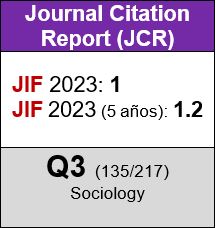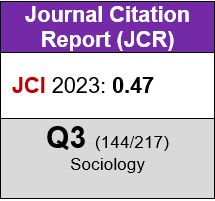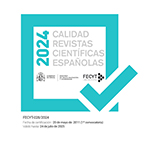La dimensión espacial de la victimización anti-LGBTI en España
DOI:
https://doi.org/10.5477/cis/reis.183.21Palabras clave:
Desigualdad, España, LGBTI, Test de independencia, VictimizaciónResumen
Las diferentes experiencias de victimización y las condiciones de vida de las personas LGBTI —lesbianas, gais, bisexuales, trans e intersexuales—, lejos de ser homogéneas, varían en el plano geográfico. Las desiguales vivencias se relacionan y comparan en distintos países, pero también regiones o municipios, algo que no ha escapado de la atención académica y mediática. A partir de datos para España de una encuesta en la Unión Europea, este artículo explora la relación de dependencia entre las respuestas sobre victimización y condiciones de vida con el lugar de residencia de las personas participantes, sobre el continuo rural-urbano. El test chicuadrado de independencia y los residuos estandarizados permiten rechazar la homogeneidad de las vivencias de las personas LGBTI, así como distinguir las problemáticas concretas para cada categoría de participantes.
Descargas
Citas
Abelson, Miriam J. (2016). «‘You Aren’t from Around Here’: Race, Masculinity, and Rural Transgen- der Men». Gender, Place & Culture, 23(11): 1535- 1546. doi: 10.1080/0966369X.2016.1219324 DOI: https://doi.org/10.1080/0966369X.2016.1219324
Agresti, Alan (2012). Categorical Data Analysis. Ho- boken, New Jersey: Wiley. DOI: https://doi.org/10.1007/978-3-642-04898-2_161
Bell, Mark (2017). Data Collection in Relation to LG- BTI People: Analysis and Comparative Review of Equality Data Collection Practices in the Eu- ropean Union. Brussels: Directorate-General for Justice and Consumers, European Union.
Bell, David y Binnie, Jon (2004). «Authenticating Queer Space: Citizenship, Urbanism and Govern- ance». Urban Studies, 41(9): 1807-1820. doi: 10. 1080/0042098042000243165 DOI: https://doi.org/10.1080/0042098042000243165
Butterfield, Nicole (2018). «Imagined Rural/Regional Spaces: Non-Normative Sexualities in Small Towns and Rural Communities in Croatia». Journal of Ho- mosexuality, 65(13): 1709-1733. doi: 10.1080/0091 8369.2017.1383111 DOI: https://doi.org/10.1080/00918369.2017.1383111
Carr, E. Summerson y Lempert, Michael (eds.) (2016). Scale. Discourse and Dimensions of Social Life. Oakland, California: University of California Press. DOI: https://doi.org/10.1525/luminos.15
Chakraborti, Neil (2018). Victims of Hate Crime. En:S. Walklate (ed.). Handbook of Victims and Victi- mology (pp. 141-155). London: Routledge. DOI: https://doi.org/10.4324/9781315712871-10
Corkley, Kevin y Awad, Germine H. (2013). «In De- fense of Quantitative Methods: Using the ‘Mas- ter’s Tools’ to Promote Social Justice». Journal of Social Action in Counseling and Psychology, 5(2): 26-41. doi: 10.33043/JSACP.5.2.26-41 DOI: https://doi.org/10.33043/JSACP.5.2.26-41
Departament d’Igualtat i Feminismes (2022). Informe sobre les denúncies i incidències per LGTBI-fò- bia a Catalunya (2021). Barcelona: Departament d’Igualtat i Feminismes, Generalitat de Cata- lunya.
Doan, Petra L. (2016). «To Count or Not to Count: Queering Measurement and the Transgen- der Community». Women’s Studies Quarterly, 44(3/4): 89-110. doi: 10.1353/wsq.2016.0037 DOI: https://doi.org/10.1353/wsq.2016.0037
Domínguez Ruiz, Ignacio E. (2017). Bifobia: etnogra- fía de la bisexualidad en el activismo LGTB. Bar- celona: Egales.
Domínguez Ruiz, Ignacio E. (2018). Cuando muera Chueca: origen, evolución y final(es) de los espa- cios LGTBI. Barcelona: Egales.
Dwyer, Angela; Ball, Matthew y Barker, Emma (2015).
«Policing LGBTIQ People in Rural Spaces: Emerg- ing Issues and Future Concerns». Rural Society, 24(3): 227-243. doi: 10.1080/10371656.2015.109 9264 DOI: https://doi.org/10.1080/10371656.2015.1099264
FELGTB (Federación Estatal de Lesbianas, Gais, Trans y Bisexuales) (2020). Informe 2019 Delitos de Odio. Madrid: FELGTB.
Fisher, Christopher M.; Irwin, Jay A. y Coleman, Jason D. (2014). «LGBT Health in the Midlands: A Rural/Urban Comparison of Basic Health Indica- tors». Journal of Homosexuality, 61(8): 1062-1090. doi: 10.1080/00918369.2014.872487 DOI: https://doi.org/10.1080/00918369.2014.872487
FRA-European Union Agency for Fundamental Rights (2013). EU LGBT Survey. European Un- ion Lesbian, Gay, Bisexual and Transgender Sur- vey. Luxembourg: Publications Office of the Eu- ropean Union.
FRA-European Union Agency for Fundamental Rights (2020a). EU-LGBTI II: A Long Way to Go for LGBTI Equality. Luxembourg: Publications Of- fice of the European Union.
FRA-European Union Agency for Fundamental Rights (2020b). EU-LGBTI II: A Long Way to Go for LG- BTI Equality. Technical Report. Luxembourg: Pub- lications Office of the European Union.
Forstie, Clare (2020). «Theory Making from the Middle: Researching LGBTQ Communities in
Small Cities». City & Community, 19(1): 153-168. doi: 10.1111/cico.12446 DOI: https://doi.org/10.1111/cico.12446
Geher, Glenn y Hall, Sara (2014). Straightforward Statistics: Understanding the Tools of Research. Oxford: Oxford University Press.
Ghaziani, Amin (2017). Sex Cultures. Cambridge: Polity Press.
Glon, Brendon; Giano, Zachary; Hubach, Randolph y Hammer, Tonya (2021). «Rurality, Gay-Related Rejection Sensibility, and Mental Health Out- comes for Gay and Bisexual Men». Journal of Gay
& Lesbian Mental Health, 25(4): 408-426. doi: 10.1 080/19359705.2020.1850595 DOI: https://doi.org/10.1080/19359705.2020.1850595
González, Sara (2005). «La geografía escalar del ca- pitalismo actual». Scripta Nova, Revista Electró- nica de Geografía y Ciencias Sociales, IX(189).
Graham, Mark (2016). Anthropological Explorations in Queer Theory. New York: Routledge. DOI: https://doi.org/10.4324/9781315567280
Grzanka, Patrick R. (2019). Queer Survey Research and the Ontological Dimensions of Heterosexism. En: A. Ghaziani y M. Brim (eds.). Imagining Queer Methods (pp. 84-102). New York: New York Uni- versity Press. DOI: https://doi.org/10.18574/nyu/9781479808557.003.0007
Guyan, Kevin (2022). Queer Data. Using Gender, Sex and Sexuality Data for Action. London: Blooms- bury. DOI: https://doi.org/10.5040/9781350230767
Haines, Staci K. (2019). The Politics of Trauma: So- matics, Healing, and Social Justice. Berkeley, California: North Atlantic Books.
Hanneman, Robert A.; Kposowa, Augustine J. y Riddle, Mark D. (2012). Basic Statistics for So- cial Research. Hoboken, New Jersey: Wiley.
Herek, Gregory M. (2004). «Beyond “Homophobia”: Thinking about Sexual Prejudice and Stigma in the Twenty-First Century». Sexuality Research & So- cial Policy, 1: 6-24. doi: 10.1525/srsp.2004.1.2.6 DOI: https://doi.org/10.1525/srsp.2004.1.2.6
Horvath, Keith J.; Iantaffi, Alex; Swinburne-Romine, Rebecca y Bockting, Walter (2014). «A Com- parison of Mental Health, Substance Use, and Sexual Risk Behaviors Between Rural and Non-Rural Transgender Persons». Journal of Homosexuality, 61(8): 1117-1130. doi: 10.1080/ DOI: https://doi.org/10.1080/00918369.2014.872502
2014.872502
Hulko, Wendy y Hovanes, Jessica (2018). «Intersec- tionality in the lives of LGBTQ Youth: Identifying as LGBTQ and Finding Community in Small Cit- ies and Rural Towns». Journal of Homosexuality, 65(4): 427-455. doi: 10.1080/00918369.2017.132 0169 DOI: https://doi.org/10.1080/00918369.2017.1320169
ILGA Europe (2022). Rainbow Europe Index 2021.Brussels: ILGA Europe.
Jubany, Olga; Langarita Adiego, Jose A. y Mas Grau, Jordi (2021). «“There is LGBTQ Life Be- yong the Big City”: Discourses, Representations and Experiences in Two Medium-Sized Spanish Cities». Journal of Homosexuality, 69(11): 1908-
doi: 10.1080/00918369.2021.1933787 DOI: https://doi.org/10.1080/00918369.2021.1933787
Kraemer, Helena Ch. y Blasey, Christine (2016). How Many Subjects? New York: Sage. doi: 10.4135/ 9781483398761
Kuhar, Roman y Švab, Alenka (2014). «The Only Gay in the Village? Everyday Life of Gays and Lesbi- ans in Rural Slovenia». Journal of Homosexuality, 61(8): 1091-1116. doi: 10.1080/00918369.2014.872492 DOI: https://doi.org/10.1080/00918369.2014.872492
Langarita Adiego, Jose A. (2020). «Sexual and Gen- der Diversity in Small Cities: LGBT Experiences in Girona, Spain». Gender, Place & Culture, 27(9): 1348-1365. doi: 10.1080/0966369X.2019.1710473 DOI: https://doi.org/10.1080/0966369X.2019.1710473
Langarita Adiego, Jose A.; Mas Grau, Jordi y Jubany, Olga (2019). «Geografías de la diversi- dad sexogenérica más allá de la gran ciudad: ex- periencias, discursos y prácticas en dos ciuda- des medianas de Cataluña». Documents d’Anàlisi Geogràfica, 65(3): 473-492. doi: 10.5565/rev/ dag.572 DOI: https://doi.org/10.5565/rev/dag.572
Langarita Adiego, Jose A.; Mas Grau, Jordi y Albertín, Pilar (2021). «Local Government Policies on Sex- ual and Gender Diversity in Spain. Experiences from Alt Empordà». Local Government Studies. do i: 10.1080/03003930.2021.1932480 DOI: https://doi.org/10.1080/03003930.2021.1932480
Lyons, Anthony; Leonard, William y Bariola, Emily (2015). «Mental Health and Resilience among Ru- ral Australian Lesbians and Gay Men». Rural So- ciety, 24(3): 244-265. doi: 10.1080/10371656.2015.1099268 DOI: https://doi.org/10.1080/10371656.2015.1099268
Martínez, Ramón (2017). Lo nuestro sí que es mun- dial: una introducción a la historia del movimiento LGTB en España. Barcelona-Madrid: Egales.
Mas Grau, Jordi y Jubany, Olga (2019). «De la ré- volution sexuelle à l’inclusion sociale des ex- pressions LGBT+. Le processus d’obtention des droits LGBT en Espagne». Drot et Culture, 77(1): 53-68. DOI: https://doi.org/10.4000/droitcultures.5101
Mereish, Ethan H. y Taylor, M. Son (2021). Sexual and Gender Minority People’s Physical Health and Health Risk Behaviors. En: K. L. Nadal y M. R. Scharrón-del Río (eds.). Queer Psychology (pp. 81-102). New York: Springer. DOI: https://doi.org/10.1007/978-3-030-74146-4_5
Michaels, Stuart; Pineau, Vicki; Reimer, Becky; Ganesh, Nedarajasundaram y Dennis, J. Michael (2019). «Test of a Hybrid Method of Sampling the LGBT Population: Web Respondent Driven Sampling with Seeds from a Probability Sam- ple». Journal of Official Statistics, 35(4): 731-752. doi: 10.1525/srsp.2004.1.2.6 DOI: https://doi.org/10.2478/jos-2019-0031
Ministerio del Interior (2020). Informe sobre la evo- lución de los delitos de odio en España. Madrid: Ministerio del Interior, Gobierno de España.
OCH (Observatori contra l’Homofòbia) (2022). L’es- tat de la LGTBI-fòbia a Catalunya. Barcelona: OCH.
OECD (2019). Society at a Glance 2019. OECD So- cial Indicators: A Spotlight on LGBT People. Paris: OECD Publishing.
Pedro, Kris T. de; Lynch, R. Jason y Esqueda, Mónica
C. (2018). «Understanding Safety, Victimization and School Climate among Rural Lesbian, Gay, Bisexual, Transgender, and Questioning (LGBTQ) Youth». Journal of LGBT Youth, 15(4): 265-279. doi: 10.1080/19361653.2018.1472050 DOI: https://doi.org/10.1080/19361653.2018.1472050
Pillet Capdepón, Félix (2008). «Las escalas del espa- cio: desde lo global a lo local». Scripta Nova, Re- vista Electrónica de Geografía y Ciencias Socia- les, XX, 270(5).
Rajaretnam, T. (2015). Statistics for Social Sciences. New York: Sage.
Rees, Samuel N.; Crowe, Maria y Harris, Shirley (2021). «The Lesbian, Gay, Bisexual and Trans- gender Communities’ Mental Health Care Needs and Experiences of Mental Health Ser- vices: An Integrative Review of Qualitative Studies». Journal of Psychiatric and Mental Health Nursing, 28(4): 578-589. doi: 10.1111/ jpm.12720 DOI: https://doi.org/10.1111/jpm.12720
Rothe, Dawn L. y Kauzlarich, David (2018). We Are All Complicit: Victimization and Crimes of the Powerful. En: S. Walklate (ed.). Handbook of Victims and Victimology (pp. 348-363). London: Routledge. DOI: https://doi.org/10.4324/9781315712871-24
Stone, Amy L. (2018). «The Geography of Re- search on LGBTQ Life: Why Sociologists Should Study the South, Rural Queers, and Ordinary Cities». Sociology Compass, 12(11): e12638. doi: 10/1111/soc4.12638 DOI: https://doi.org/10.1111/soc4.12638
Thorsteinsson, Einar B.; Bjardnson, Thoroddur; Loi, Natasha M. y Arnarsson, Arsaell M. (2022). «Sex- ual Orientation and Migration Intentions among Rural, Exurban and Urban Adolescents in Ice- land». Culture, Health & Sexuality, 24(1): 31-47. doi: 10.1080/13691058.2020.1813333 DOI: https://doi.org/10.1080/13691058.2020.1813333
Wagner III, William E. y Gillespie, Brian J. (2019). Us- ing and Interpreting Statistics in the Social, Be- havioral, and Health Sciences. New York: Sage.
Walters, Mark A. (2014). Hate Crime and Restorative Justice: Exploring Causes, Repairing Harm. Ox- ford: Oxford University Press. DOI: https://doi.org/10.1093/acprof:oso/9780199684496.001.0001
Walters, Mark A. (2019). «Repairing the Harms of Hate Crime: Towards a Restorative Justice Ap-proach». En: Actas del 171st International Senior Seminar of the United Nations Asia and Far East Institute for the Prevention of Crime and Treat- ment of Offenders Criminal justice Response to Crimes Motivated by Intolerance and Discrimina- tion. Disponible en: https://www.unafei.or.jp/pub- lications/pdf/RS_No108/No108_10_VE_Walters. pdf, acceso 15 de marzo de 2023.
Descargas
Publicado
Cómo citar
Número
Sección
Licencia
Derechos de autor 2023 REIS. Revista Española de Investigaciones Sociológicas

Esta obra está bajo una licencia internacional Creative Commons Atribución-CompartirIgual 4.0.
Permite Compartir — copiar y redistribuir el material en cualquier medio o formato, Adaptar — remezclar, transformar y construir a partir del material para cualquier propósito, incluso comercialmente.








